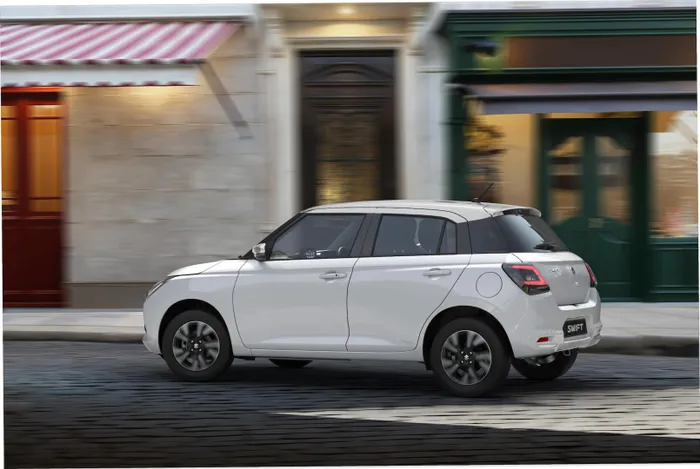Toyota and Suzuki lead the charge in South Africa's booming car market

Toyota South Africa Motors (TSAM) reaffirmed its dominance, recording 13,559 new vehicle sales in October and capturing a 24.2% market share.
Image: Supplied
South Africa’s new vehicle market kept its wheels turning in October, driven by improving consumer sentiment, a firmer rand and revived demand from export markets.
According to The Automotive Business Council (NAAMSA), total sales climbed to 55,956 units, representing a solid 16% year-on-year increase.
Passenger cars were the month’s best performers, surging 14.8% year-on-year to reach 39,610 units, the best result since October 2014.
Light commercial vehicles (LCVs) followed with a 23.9% jump, while medium commercial vehicles (MCVs) grew by 9.3%. Heavy trucks, however, dipped slightly by 1%, reflecting the uneven pace of recovery across market segments.
Despite a slower growth rate compared to September, the sector continues to demonstrate resilience. With steady interest rates, easing inflation and healthy fleet demand, manufacturers are heading into the year’s final stretch with confidence.
Toyota still leads
Toyota South Africa Motors (TSAM) reaffirmed its dominance, recording 13,559 new vehicle sales in October and capturing a 24.2% market share, almost a quarter of the entire market.
“We are proud of Toyota’s performance across all segments, from entry-level to luxury,” said Leon Theron, senior vice president of Sales and Marketing at TSAM.
“These results reaffirm the trust South Africans continue to place in Toyota, Lexus and Hino products. Our strong dealer network and commitment to quality continue to resonate with customers.”
In the passenger car arena, Toyota led the field with 8,432 units sold, bolstered by the Corolla Cross (1,615), Starlet (1,613), Urban Cruiser (1,360), Starlet Cross (1,011) and Vitz (1,200). On the premium end, Lexus maintained its steady presence, delivering 79 vehicles, led by the NX (31) and LX (11).
The Hilux continued to be the country’s best-selling bakkie, with 3,533 units finding new homes and a commanding 27.9% share of the LCV market. Supporting the line-up were the Hiace Taxi (617 units), Land Cruiser 79 (414 units) and Land Cruiser Prado (139 units).
Hino’s commercial trucks also contributed to Toyota’s strong showing, adding 253 sales to the total. Fleet business remained robust too, with more than 2,150 fleet customers opting for Toyota models in October, particularly the Hilux, Vitz, and Starlet.
Toyota’s parts division moved an impressive two million pieces locally and exported 393,000 components internationally. Vehicle exports totalled 4,436 units, underscoring the brand’s contribution to South Africa’s industrial base.

Suzuki Auto South Africa had another record month with the Swift leading the charts.
Image: Supplied
Another Suzuki record
While Toyota remains the undisputed market leader, Suzuki Auto South Africa continued to punch well above its weight, celebrating a new monthly record.
The Japanese manufacturer sold 6,890 vehicles in October, beating its previous August peak of 6,534 units and in doing so retaining its place as the country’s second-best-selling brand.
Dealer sales accounted for 4,842 units, while fleet, government, and rental sales contributed another 2,048. This marks the fourth consecutive month Suzuki has exceeded the 6,000-unit mark.
Leading the charge was the popular Swift hatchback, topping Suzuki’s charts with 2,377 units sold. It was followed by the Fronx crossover (1,369), Baleno (596), Ertiga MPV (521) and Dzire sedan (409).
“We are absolutely thrilled to set a new monthly sales record,” said Henno Havenga, GM of Auto Sales and Marketing at Suzuki Auto SA.
“From our best-selling Swift to our versatile SUV and commercial range, every model has played a part in this achievement. Our dealer network’s dedication and passion are key to our continued success.”
Two months left
October’s performance signals renewed confidence in South Africa’s automotive market, with both industry heavyweights and value-focused brands benefiting from improved affordability and market stability.
Toyota’s broad product portfolio - spanning budget hatchbacks, rugged bakkies and luxury SUVs - continues to anchor its leadership position, while Suzuki’s consistent double-digit growth underlines the appetite for reliable, efficient small cars.
If the current momentum holds, 2025 could end on a high note for local manufacturers, dealers and consumers alike, setting the stage for an even more competitive year ahead.
Related Topics: